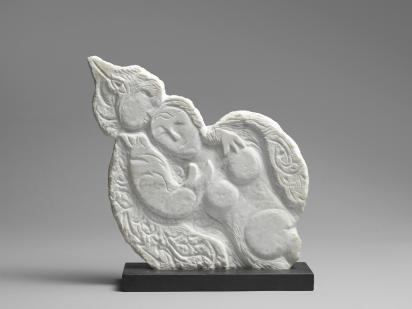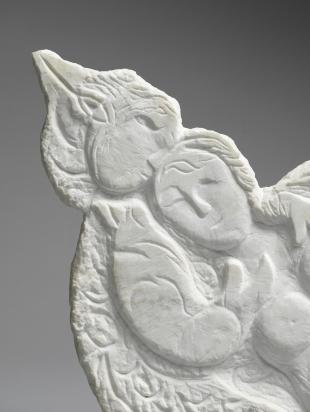Low-relief in marble, echoing the shape of an arrowhead. Couple With a Bird depicts two lovers in an embrace, a recurring theme in Chagall’s work. The man’s profile changes into a rooster head, his hands as sharp talons, wrapping his outspread wings around the couple. Present in many paintings, the double profile and zoomorphic depiction of the artist as a rooster tie Chagall to his totem animal, symbolizing his Russian ancestry and his awakening to the world, like a rooster crowing every morning at sunrise. In the pieces Commedia dell'arte [Commedia dell'arte] (1959) and The Rooster [Le Coq] (1947) this bird is associated with the need for renewal and with the human conscience. It is a benevolent figure whose open eye is drawn out into a beak, pointing toward the sky like a prophetic finger. A prophylactic figure, as described in the poem The Golden Cockerel by Alexander Pushkin (1834), the rooster creates a cocoon to protect the couple as they take flight, a theme also present in his pictorial works from the same period (Lovers with Pole or Couple in Chains [Les Amoureux au poteau ou Couple enchaîné] (1951) and Rooster With Lovers [Le Coq aux amoureux] (1947 - 1950)).
The rough carving of the stone, following the contours of the couple and the bird’s beak, plays on formal contrasts to create a work that can be interpreted in two ways, where couple and bird merge to become one. By juxtaposing and carving out elements, the artist reveals the wealth of his inspirations, evoking the structure of lubok (Russian popular imagery) within which the iconography of the rooster has been deployed since the early seventeenth century, as well as the chiseled low reliefs of Khmer temples1, garlands, crosses, and foliage. Listening to the materials, Marc Chagall listens to cultures as well, never seeking to imitate but “to listen attentively to the messages of these peoples and [their] arts”2. The purity of white marble is combined with incisions of varying depths, which establish a rhythm on the surface of the stone. Bodies, treated in an understated manner without decorative effects, contrast with the rooster’s plumage, which is covered in arabesques and circular patterns. Accentuating the graphic geometry of the lines, these ornamental patterns echo the lush vegetation featured in illuminated manuscripts and on Jewish tombstones of the eighteenth and nineteenth centuries, and also visible on the low reliefs Donkey, Fish, Moon, and Two Birds or La Colline [Âne, poisson, lune et deux oiseaux ou La Colline] (circa 1966) or Two Birds and a Rabbit or La Colline [Deux oiseaux et un lapin ou La Colline] (circa 1966).



